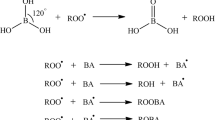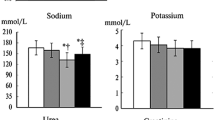Abstract
Humic acid is an antioxidant molecule used in agriculture and livestock breeding, as well as in medicine. Our aim was to investigate the potential renoprotective effects of humic acid in a renal ischemia reperfusion model. Twenty-one rats were randomly divided into three equal groups. Intraperitoneal serum or humic acid was injected at 1, 12, and 24 h. Non-ischemic group I was evaluated as sham. The left renal artery was clamped in serum (group II) and intraperitoneal humic acid (group III) to subject to left renal ischemic reperfusion procedure. Ischemia and reperfusion time was 60 min for each. Total antioxidant status, total oxidative status, oxidative stress index, and ischemia-modified albumin levels were analyzed biochemically from the serum samples. Kidneys were evaluated histopatologically and immunohistochemically. Biochemical results showed that total oxidative status, ischemia-modified albumin, and oxidative stress index levels were significantly decreased, but total antioxidant status was increased in the humic acid group (III) compared with the ischemia group (II) On histopathological examination, renal tubular dilatation, tubular cell damage and necrosis, dilatation of Bowman’s capsule, hyaline casts, and tubular cell spillage were decreased in the humic acid group (III) compared with the ischemia group (II). Immunohistochemical results showed that apoptosis was deteriorated in group III. Renal ischemia reperfusion injury was attenuated by humic acid administration. These observations indicate that humic acid may have a potential therapeutic effect on renal ischemia reperfusion injury by preventing oxidative stress.



Similar content being viewed by others
References
Hartenstein, R. 1981. Sludge decomposition and stabilization. Science 212(4496): 743–9.
Chen, Y., J. Katan, A. Gamliel, T. Aviad, and M. Schnitzer. 2000. Involvement of soluble organic matter in increased plant growth in solarized soils. Biology and Fertility of Soils 32(1): 28–34.
Efimova, I., S. Khil’ko, and O. Smirnova. 2012. Antioxidant activity of humic acids in radical-chain oxidation processes. Russian Journal of Applied Chemistry 85(9): 1351–4.
Gostishcheva, M.V., M.V. Belousov, M.S. Yusubov, R.R. Ismatova, and S.E. Dmitruk. 2009. Comparative IR spectral characteristics of humic acids from peats of different origin in the Tomsk Area. Pharmaceutical Chemistry Journal 43: 418–21.
Van Rensburg, C., J. Dekker, R. Weis, T.L. Smith, E. van Janse Rensburg, and J. Schneider. 2002. Investigation of the anti-HIV properties of oxihumate. Chemotherapy 48(3): 138–43.
Van Rensburg, C., A. Van Straten, and J. Dekker. 2000. An in vitro investigation of the antimicrobial activity of oxifulvic acid. Journal of Antimicrobial Chemotherapy 46(5): 853–4.
Vucskits, A., I. Hullár, A. Bersényi, E. Andrásofszky, M. Kulcsár, and J. Szabó. 2010. Effect of fulvic and humic acids on performance, immune response and thyroid function in rats. Journal of Animal Physiology and Animal Nutrition 94(6): 721–8.
Bar-Or, D., E. Lau, and J.V. Winkler. 2000. A novel assay for cobalt-albumin binding and its potential as a marker for myocardial ischemia—a preliminary report. Journal of Emergency Medicine 19(4): 311–5.
Erel, O. 2004. A novel automated method to measure total antioxidant response against potent free radical reactions. Clinical Biochemistry 37(2): 112–9.
Erel, O. 2005. A new automated colorimetric method for measuring total oxidant status. Clinical Biochemistry 38(12): 1103–11.
McCord, J.M. 2000. The evolution of free radicals and oxidative stress. American Journal of Medicine 108(8): 652–9.
Ozturk, H., H. Ozturk, E.H. Terzi, U. Ozgen, A. Duran, and I. Uygun. 2014. Protective effects of Rosmarinic acid against renal ischaemia/reperfusion injury in rats. Journal of the Pakistan Medical Association 64(3): 260–5.
Sinha, M., D. Roy, D. Gaze, P. Collinson, and J. Kaski. 2004. Role of “Ischemia modified albumin”, a new biochemical marker of myocardial ischaemia, in the early diagnosis of acute coronary syndromes. Emergency Medicine Journal 21(1): 29–34.
Kocan, H., S. Citgez, U. Yucetas, et al. 2014. Can ischemia-modified albumin be used as an objective biomarker for renal ischemic damage? An experimental study with Wistar albino rats. Transplantation Proceedings 46(10): 3326–9.
Packer, J.E., T.F. Slater, and R.L. Willson. 1979. Direct observation of a free radical interaction between vitamin E and vitamin C. Nature 278(5706): 737–738.
Stocker, R., M.J. Weidemann, and N.H. Hunt. 1986. Possible mechanisms responsible for the increased ascorbic acid content of Plasmodium vinckei-infected mouse erythrocytes. Biochimica et Biophysica Acta 881(3): 391–7.
Hu, H., C. Zou, X. Xi, et al. 2012. Protective effects of pioglitazone on renal ischemia-reperfusion injury in mice. Journal of Surgical Research 178(1): 460–5.
Zou, C., H. Hu, X. Xi, Z. Shi, G. Wang, and X. Huang. 2013. Pioglitazone protects against renal ischemia-reperfusion injury by enhancing antioxidant capacity. Journal of Surgical Research 184(2): 1092–5.
Nohl, H., L. Gille, and K. Staniek. 2005. Intracellular generation of reactive oxygen species by mitochondria. Biochemical Pharmacology 69(5): 719–23.
Kosecik, M., O. Erel, E. Sevinc, and S. Selek. 2005. Increased oxidative stress in children exposed to passive smoking. International Journal of Cardiology 100(1): 61–4.
Ceylan, E., A. Gülsün, M. Gencer, and N. Aksoy. 2005. A new parameter in the detection of tuberculosis activity: reactive oxygen metabolites. Respiration 72(2): 156–9.
Nakamura, K., H. Endo, and S. Kashiwazaki. 1986. Serum oxidation activities and rheumatoid arthritis. International Journal of Tissue Reactions 9(4): 307–16.
Ozkan, A., H.M. Sen, I. Sehitoglu, et al. 2015. Neuroprotective effect of humic acid on focal cerebral ischemia injury: an experimental study in rats. Inflammation 38(1): 32–9.
Acknowledgments
This work was supported by the Research Fund of Çanakkale Onsekiz Mart University. Project Number 159.
Author information
Authors and Affiliations
Corresponding author
Rights and permissions
About this article
Cite this article
Akbas, A., Silan, C., Gulpinar, M.T. et al. Renoprotective Effect of Humic Acid on Renal Ischemia-Reperfusion Injury: An Experimental Study in Rats. Inflammation 38, 2042–2048 (2015). https://doi.org/10.1007/s10753-015-0185-2
Published:
Issue Date:
DOI: https://doi.org/10.1007/s10753-015-0185-2




